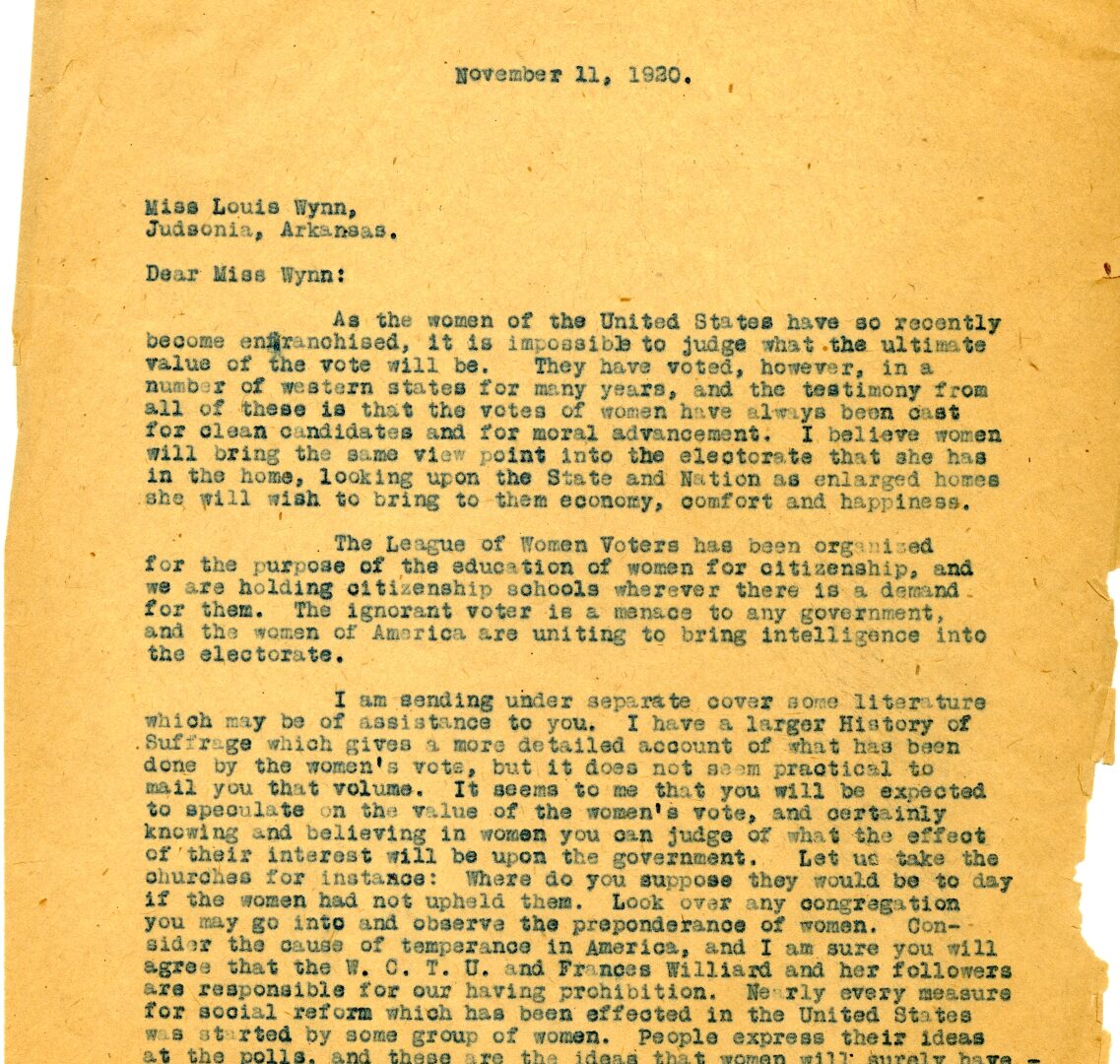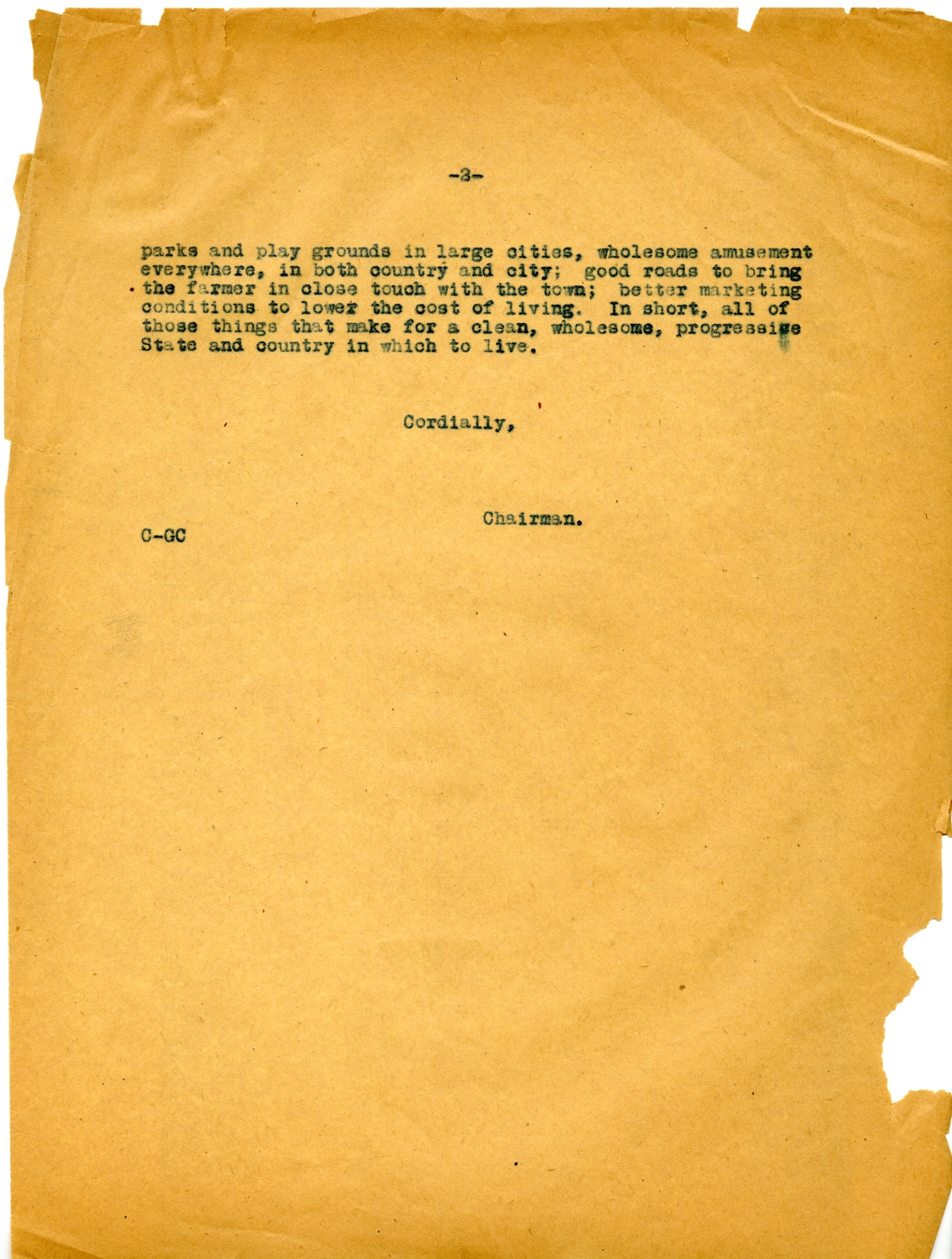Introduction
The first serious attempt to grant Arkansas women the right to vote emerged shortly after the Civil War, when Miles Ledford Langley of Arkadelphia proposed at the 1868 Arkansas Constitutional Convention that “all citizens 21 years of age, who can read and write the English language” should be eligible to vote. While this proposal was rejected, the fight for women’s voting rights did not cease. Women advocating the idea of equal political participation of men and women, known at the time as suffragists, engaged in a variety of tactics and strategies that pushed their agenda. They created suffrage clubs, published and distributed suffrage newspapers and pamphlets, organized marches, parades, and rallies, and sent petitions to state and national legislatures that demanded voting rights for women. In 1917, all these efforts resulted in Arkansas women gaining the right to vote in primary elections.
One of the key activists fighting for women’s voting rights in Arkansas was Florence Brown Cotnam. Cotnam was a member of multiple suffrage organizations and served as president of the Little Rock Political Equality League. In 1914, several suffrage organizations joined with the Little Rock Political Equality League to create the Arkansas Woman Suffrage Association, and Cotnam was elected the new organization’s treasurer. She was an inspiring public speaker and used her talents to convince others that women should have the right to equal political participation. Between 1915 and 1920, Cotnam traveled across twenty states to advocate women’s suffrage. In 1915, she was also the first woman to address the Arkansas General Assembly.
In 1919, Congress passed the federal women’s suffrage amendment, which was ratified and certified in August 1920. Following this momentous achievement, Cotnam and her fellow suffragists focused on citizenship education. Cotnam led the League of Women Voters of Little Rock, an organization that worked to educate women about their new rights and responsibilities as voters. The idea of educated citizenship was central to those efforts. In this activity, you will examine a letter that Cotnam wrote to Louis Wynn of Judsonia, Arkansas. In it, she discusses women’s contributions to social changes and civic responsibilities.
Activity Questions
Florence Brown Cotnam correspondence with League of Women Voters; Letter from the Chairman to Louis Wynn, page 2
- This letter was written by the “Chairman” of the League of Women Voters Florence Brown Cotnam to a person named Louis Wynn (we do not know anything about Wynn). How long after the ratification of the Nineteenth Amendment did Cotnam write this letter?
- Why does Cotnam refer to “western states” in the opening paragraph? If you are not sure, research the first five US territories and/or states that granted women suffrage. Note that some states gave women limited voting rights in some elections (e.g., school boards) before they granted them full voting rights. Research first five territories/states that granted women unrestricted (full) voting rights.
- What is the purpose of the League of Women Voters? Explain in your own words.
- What examples does Cotnam use to argue that women have already had a positive impact on their communities and on government? What causes have women led according to Cotnam?
- In her letter, Cotnam suggests that women are more moral and honest because they elect “clean candidates” and support “moral advancement.” Do you agree with her? Do women vote differently than men? Research demographic data from any recent election to support your argument.
- Cotnam and her collaborators worked to educate women about their rights and responsibilities as citizens. In what ways can we be more educated citizens today? List three strategies that can help us be more educated about our rights and responsibilities as citizens.
Primary Sources
To learn more about the primary sources featured in the activities above, click the following links:
Arkansas Social Studies Standards
Arkansas History, Grades 7 – 8
- Strand: History
- Content Standard 7: Students will examine the impact of historical events and people on the development of Arkansas
- H.7.AH.7-8.9 Examine social and cultural transformations in Arkansas
- H.7.AH.7-8.10 Research contributions made by Arkansans in the fields of art, medicine, politics, science, and technology in the 20th and 21st centuries
- H.7.AH.7-8.11 Construct historical arguments about the contributions made by various political and military leaders in Arkansas
Arkansas History, Grades 9 – 12
- Strand: Era 4: Early 20th Century 1901-1940
- Content Standard 4: Students will analyze factors that influenced the perspectives of Arkansans in the early 20th century.
- Era4.4.AH.9-12.1 Investigate social, economic, and political reforms of the Progressive Era in Arkansas from multiple perspectives using a variety of primary and secondary sources
- Era4.4.AH.9-12.3 Evaluate effects of World War I on Arkansans using a variety of primary and secondary sources
US History Since 1890, Grades 9 – 12
- Strand: Era 7: Emergence of Modern America 1890-1930
- Content Standard 2: Students will evaluate social, economic, and political changes in the United States between 1890 and 1930.
- Era7.2.USH.3 Analyze short- and long-term social, economic, political, educational, and environmental effects of progressivism at the local, state, and national levels
- Era7.2.USH.5 Examine reasons for and effects of social, economic, political, and cultural changes during the 1920s
- Era7.2.USH.6 Construct historical arguments and explanations about the long-term impact of social, economic, political, and cultural changes that occurred during the 1920s utilizing evidence from a variety of primary and secondary sources
Key Terms
Downloadable Guides and Handouts
We encourage K-12 educators to use History Alive: Virtually! in a way that will best match their classroom needs. The “Exercise” handout includes a complete exercise as featured on this website, the “Primary Sources” handout includes only primary sources used in the exercise, and the “Questions” handout includes analytical questions from the exercise but is editable and can be easily changed to best match students’ needs.
Educated Citizenship – Exercises


